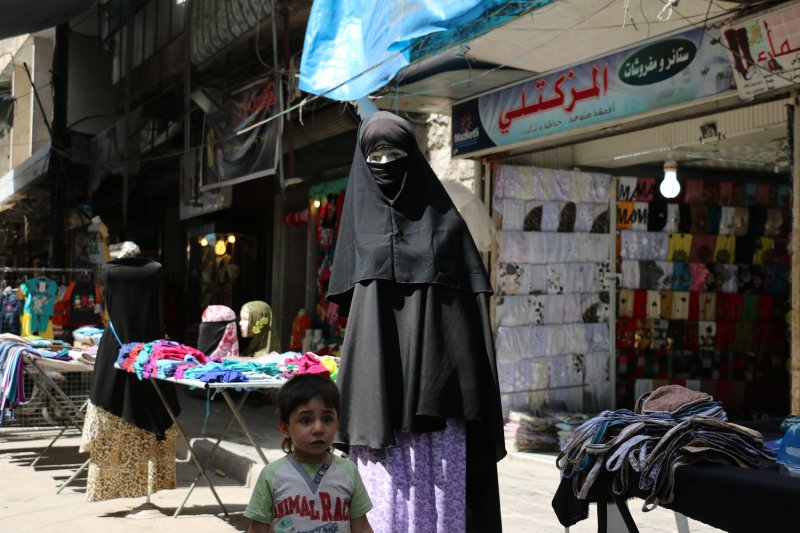1 of 2 | Vendors sell in the rebel-held Bustan al-Qasr district in eastern Aleppo, Syria on May 21. File Photo by Ameer Alhalbi/ UPI |
License Photo
ISTANBUL, Turkey -- When tourists arrived in Aleppo, the first place we would take them was the old city and its citadel. People loved the old covered market and the narrow alleys. Then we would drive them around to show them the modern side of Aleppo, the western side, with wide tree-lined streets and neighborhoods with million-dollar houses.
I loved my city and the area where I lived, which I found particularly beautiful. For some time, I thought all of Aleppo was like this but as I got older I started venturing out of my comfort zone to neighborhoods in the east of the city and the surrounding countryside.
I noticed right away the huge contrast between these poorer areas and my neighborhood. While we had wide streets, they had narrow ones, with buildings cramped close to each other and garbage everywhere.
I recall the maintenance man at our hospital who used to park his small truck in front.
When I asked him why he did not park outside his home, he said he transported goods for people after his hospital shift. The eastern part of town, though, had a problem, he said. It was common for the city to start repairs that were never finished, cutting off access to roads around his home. The last time he parked the truck in front of his building, he was unable to move it for about a month and he lost many hours of work.
I later learned that someone like him earns about $200 a month and most Syrians like him work two jobs to make ends meet, especially if they are from eastern Aleppo.
Aleppo was never a hotbed of political demonstrations but by 2011 you could sense the tension as unrest grew across the country and eventually reached Aleppo. In the densely populated areas of eastern Aleppo, which occupied half the city space but housed two-thirds of its 3 million inhabitants, demonstrations flourished.
In August 2012, war broke out in Aleppo. With local rebels taking over most of the countryside, it seemed inevitable when they entered the city. At the time, eastern Aleppo welcomed them with open arms. In the western part, the situation was not the same. People did not think that this was their fight. They were well off so the attitude was: "Who cares if we don't have democracy?"
But the war was upon us and government forces gave up on the poor neighborhoods of Aleppo and concentrated on defending the affluent neighborhoods. After all, these were the people who mattered to the regime.
The front line of the war became the old city while eastern Aleppo was pummelled by regime air power and artillery. The rebels tried for some time to retaliate but they were never a match for the superior firepower of the regime.
For three years fighting ebbed and flowed, but then the regime, with the aid of Russian air power and Iranian-backed ground forces, encircled eastern Aleppo and kept supplies from reaching the 300,000 people living inside.
For the last two months, we have witnessed bombing that only places such as Dresden, Sarajevo or Grozny have witnessed. Perhaps none of these cities suffered as much as Aleppo, certainly not for as long a time.
To give one an idea of the scale of the damage, one of my friends became homeless twice in two months. First, because his home was destroyed and then, when he moved in with his parents, their home was destroyed. He, his wife and three children are homeless again and he has to take care of his father and mother, who cannot walk after the last attack.
When I asked him how he is coping, he said: "Our food is running out but I thank God that we are still alive. Until when I can't tell you. My only wish is that if I have to die that I die quickly."
This is the 2016 version of Aleppo, one of the oldest cities in the world, once a place of great beauty, whose ancient streets and sights enchanted anyone who entered it. It is now in ruins.
Beyond the terrible human loss, the world is losing a big piece of history, a city as old as civilization itself. French archaeologist Andre Parrot once said: "Each civilized person in the world should admit that he has two home countries: The one he was born in and Syria." In the global village in which we live, that is true now more than ever.
Watching my hometown destroyed from across the world, from the safety of the United States, is like seeing a loved one die slowly before my eyes, unable to help her. For those leaders who can help, please enact a no-fly zone, find a way to stop the killing and get the people food and other aid before there is no city to save.
Shadi Martini is director of International relations of Orient For Human Relief, a charity that has its headquarters in Turkey. This article originally appeared at The Arab Weekly.















